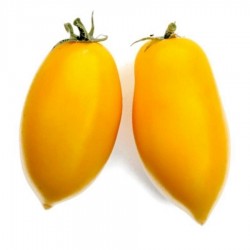Menu
-
MenuBack
- Home
-
Categories
-
-
Categories
-
Vegetable Seeds
-
Varieties by Country
- Varieties from Armenia
- Varieties from BiH
- Varieties from Croatia
- Varieties from France
- Varieties from Germany
- Varieties from Greece
- Varieties from Hungary
- Varieties from India
- Varieties from Italy
- Varieties from Japan
- Varieties from North Macedonia
- Varieties from Peru
- Varieties from Russia
- Varieties from Serbia
- Varieties from Slovenia
- Varieties from Spain
- Varieties from Thailand
- Varieties from Turkey
- Varieties from USA
- Tomato Seeds
- Corn Seeds
- Gourd family
- Bean family
- Cucumber Seeds
- Pepper Seeds
- Carrot family
- Onion family
- Lettuce Seeds
- Potato family
- Cabbage family
- Radish Seeds
- Beetroot family
- Watermelon Seeds
- Melon Seeds
- Cauliflower Seeds
- Sunflower family
-
Varieties by Country
- Fruit Seeds
- Chili - Habanero Seeds
- Medicinal Herb Seeds
- Climbing Plants Seeds
- Trees Bonsai Seeds
- Palm Seeds
- Ornamental Grasses Seeds
- Tobacco Seeds
-
Vegetable Seeds
-
-
-
-
- NEW PRODUCTS
- Create account
- Delivery - Payment
- FAQ
List of products by brand Seeds Gallery
Seeds produced by Seeds Gallery
Seeds produced by Seeds Gallery
There are 408 products.
Showing 301-312 of 408 item(s)
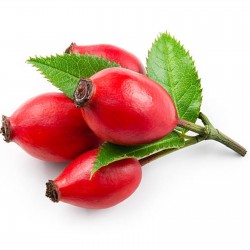
Rose Hip Seeds - Rose Haw -...
Price
€2.15
SKU: MHS 122
Seeds Gallery Com,
5/
5
<h2><strong>Rose Hip Seeds - Rose Haw - Rose Hep (Rosa canina)</strong></h2>
<h2><span style="color: #ff0000;"><strong>Price for Package of 1g (65+-) seeds.</strong></span></h2>
<p>The rose hip, also known as rose haw or rose hep, is the fruit of the rose plant, that typically is red-to-orange, but ranges from dark purple to black in some species. Rose hips begin to form after successful pollination of flowers in spring or early summer and ripen in late summer through autumn.</p>
<p><strong>Usage</strong></p>
<p>Rose hips are used for tisanes, jam, jelly, syrup, soup, beverages, pies, bread, wine, and marmalade. They can also be eaten raw, like a berry, if care is used to avoid the hairs inside the fruit.</p>
<p>A few rose species are sometimes grown for the ornamental value of their hips, such as Rosa moyesii, which has prominent large red bottle-shaped fruits.</p>
<p>Rose hips have recently[when?] become popular as a healthy treat for pet chinchillas and guinea pigs. These small rodents are unable to manufacture their own vitamin C and are unable to digest many vitamin-C rich foods. Rose hips provide a sugarless, safe way to increase their vitamin C intake.</p>
<p>Rose hips are also fed to horses. The dried and powdered form can be fed at a maximum of 1 tablespoon per day to improve coat condition and new hoof growth.</p>
<p>The fine hairs found inside rose hips are used as itching powder. Dried rose hips are also sold for primitive crafts and home fragrance purposes.</p>
<p>Rose hips were used in many food preparations by the indigenous peoples of the Americas.</p>
<p> Rose hips can be used to make Palinka, a traditional Hungarian alcoholic beverage. They are also the central ingredient of Cockta, the fruity-tasting national soft drink of Slovenia.</p>
<p>In his book Stalking the Faraway Places, wild foods enthusiast Euell Gibbons recommended stuffed rose hips made by slicing a large hip in half, removing the seeds and inserting a wild raspberry.</p>
<p>Rose hips are commonly used as a tisane, often blended with hibiscus, and also as an oil. They can also be used to make jam, jelly, marmalade, and rose hip wine. Rose hip soup, "nyponsoppa", is especially popular in Sweden. Rhodomel, a type of mead, is made with rose hips.</p>
<p><strong>Medical uses</strong></p>
<p>Rose hips are particularly high in vitamin C content, one of the richest plant sources available. However, RP-HPLC assays of fresh rose hips and several commercially available products revealed a wide range of L-ascorbic acid content, ranging from 0.03 to 1.3%.[2] Rose hips of some species, especially Rosa canina (Dog Rose) and R. majalis, have been used as a source of vitamin C. During World War II, the people of Britain were encouraged through letters to The Times newspaper, articles in the British Medical Journal, and pamphlets produced by Claire Loewenfeld, a dietitian working for Great Ormond Street Hospital for Sick Children, to gather wild-grown rose hips and to make a vitamin C syrup for children. This was because German submarines were sinking many commercial ships: citrus fruits from the tropics were very difficult to import.</p>
<p>Rose hips contain plenty of lycopene, an important and strong antioxidant that prevents oxidation of low density lipoprotein (LDL) as well as of many cellular membranes.[3] Lycopene in rose hips differs more in its isomer distribution than in other sources (tomatoes, pink grapefruit).[citation needed]</p>
<p>Rose hips also contain some vitamin A and B, essential fatty acids, and antioxidant flavonoids.</p>
<p>A study of a rose hip preparation for treating rheumatoid arthritis concluded that there was a benefit, apparently due to both anti-inflammatory and anti-oxidant effects.</p>
<p>Rose hips are used to help prevent colds and influenza.</p>
<p><strong>Propagation</strong></p>
<p>Roses are propagated from hips by removing the achenes that contain the seeds from the hypanthium (the outer coating) and sowing just beneath the surface of the soil. The seeds can take many months to germinate. Most species require chilling (stratification), with some such as Rosa canina only germinating after two winter chill periods have occurred.</p><script src="//cdn.public.n1ed.com/G3OMDFLT/widgets.js"></script>
MHS 122 (1g)

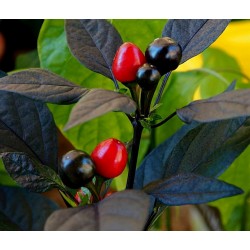
Royal Black Chili Seeds
Price
€2.35
SKU: C 43
Seeds Gallery Com,
5/
5
<h2><strong><em><span style="text-decoration:underline;">Royal Black Chili Seeds</span></em></strong></h2>
<h3><strong><span style="color:#ff0000;">Price for Package of 10 seeds.<br /></span></strong></h3>
<div>Royal Black – one of the most elegant chillies you can grow in your garden, adding a lovely oriental accent to a patio or flowerbed. The plant is tall and bushy, with dark purple foliage that has the occasional leaf tip of white and green. The bullet-shaped pequin pods are both flavoursome and hot, starting out a dark purple shade and ripening to bright red.</div>
<div>Organic seeds: Yes</div>
<div><span style="font-size:12pt;color:#0000ff;"><strong><em><a href="http://www.youtube.com/watch/?v=o2gsIBtIUvI&feature=plcp" target="_blank" rel="noreferrer noopener"><span style="color:#0000ff;">http://www.youtube.com/watch?v=o2gsIBtIUvI&feature=plcp</span></a></em></strong></span></div>
C 43

.png)
Variety from Greece

This plant has giant fruits
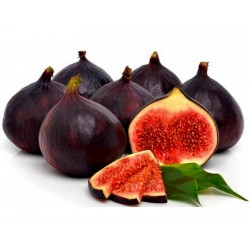
Royal Black Greek Fig Seeds...
Price
€2.15
SKU: V 19 RBG
Seeds Gallery Com,
5/
5
<h2><strong>Royal Black Greek Fig Seeds - Vasilika Mavra (Βασιλικά Μαύρα)</strong></h2>
<h2><span style="color: #ff0000;" class=""><strong>Price for Package of 50 (0,02g) seeds.</strong></span></h2>
<p>Vasilika Mavra or the "Royal Black Greek Fig" is said to be the best tasting of the Greek figs. It is widely grown in Greece. The outside is very dark purple to black and the inside is red.</p>
<p>Our experience has been after a couple of years of growing this variety is that Vasilika Mavra produces many very nice dark purple figs that have dropped before they were mature inside. The size, depth of color, and number have grown year over year for us. We hope as the mother trees mature the figs will hold as other varieties have.</p>
<p>Those fortunate enough to have tried this fig describe it as berry and honey flavored, thick and jammy.</p>
<p>Vasilika Mavra produces super sweet “figs” that continues to the end of the season.</p>
<p>Other names: Royal Black Greek Fig, Βασιλικά Μαύρα,</p><script src="//cdn.public.n1ed.com/G3OMDFLT/widgets.js"></script>
V 19 RBG (0,02g)

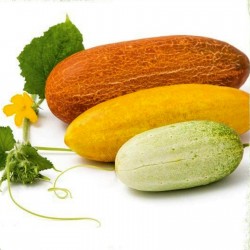
Russian Cucumber Seeds...
Price
€1.65
SKU: PK 3
Seeds Gallery Com,
5/
5
<!DOCTYPE html>
<html>
<head>
<meta http-equiv="Content-Type" content="text/html; charset=UTF-8" />
</head>
<body>
<h2><strong>Russian Cucumber Seeds Russkaja</strong></h2>
<h2><span style="color: #ff0000;"><strong>Price for Package of 5 seeds.</strong></span></h2>
<p>Robust Russian cucumber for outdoor cultivation. Early variety, 39-43 days from germination to harvest. It can be picked at all stages of maturity. It has a very long shelf life. The plant is very durable and ideal for growing outdoors.</p>
<p>The fruits are short, 9-15 cm long, 5 to 7 cm thick. The young fruit has a green color, then when the fruit ripens it turns orange. The fruits can be used at all stages of maturity.</p>
<p>It can be eaten raw like any other cucumber or for salads or cooked (in soups, sauces).</p>
<p>Cucumis Sativus var. sikkimensis</p>
<p>Long shelf life.<br />Taste: very mild.<br />Preculture: from April.<br />No-till: from mid-May.<br />Harvest: from August.<br />Location: Warm and sunny, moist soil.</p>
</body>
</html>
PK 3 (5 S)

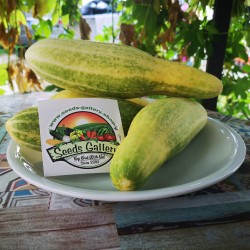
Russian Murom cucumber seeds
Price
€1.65
SKU: PK 2
Seeds Gallery Com,
5/
5
<!DOCTYPE html>
<html>
<head>
<meta http-equiv="Content-Type" content="text/html; charset=UTF-8" />
</head>
<body>
<h2><strong>Russian Murom cucumber seeds</strong></h2>
<h2><span style="color: #ff0000;"><strong>Price for Package of 5 seeds.</strong></span></h2>
<p>An old robust cucumber from the city of Murom ( Murom cucumber, Murom is a historical city in Vladimir Oblast, Russia, which sprawls along the left bank of the Oka River.).</p>
<p>Murom cucumber characteristics, early 35 - 40 days from germination to harvest, with white stripes, it is 25 cm long, the weight of 500 grams, it remains green much longer without turning yellow. It can be picked at all stages of maturity.</p>
<p>But what you can't deny is that incomparable aroma and taste of a real Russian cucumber, which he carried through a century. It has excellent properties, no bitterness, never empty and soft, early maturity, and a huge crop, which are very important for a cold climate. Good resistance to powdery mildew.</p>
</body>
</html>
PK 2 (5 S)

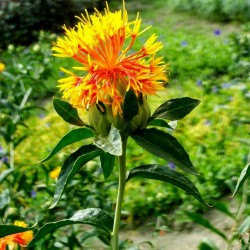
Safflower Seeds (Carthamus...
Price
€1.95
SKU: MHS 21
Seeds Gallery Com,
5/
5
<!DOCTYPE html>
<html>
<head>
<meta http-equiv="Content-Type" content="text/html; charset=UTF-8" />
</head>
<body>
<h2><strong>Safflower Seeds (Saffron Substitute) (Carthamus tinctorius)</strong></h2>
<h2><span style="color: #ff0000;"><strong>Price for Package of 10 seeds.</strong></span></h2>
<p>Safflower (Carthamus tinctorius) is a highly branched, herbaceous, thistle-like annual plant. It is commercially cultivated for vegetable oil extracted from the seeds and was used by the early Spanish colonies along the Rio Grande as a substitute for saffron. Plants are 30 to 150 cm (12 to 59 in) tall with globular flower heads having yellow, orange, or red flowers. Each branch will usually have from one to five flower heads containing 15 to 20 seeds per head. Safflower is native to arid environments having seasonal rain. It grows a deep taproot which enables it to thrive in such environments.</p>
<p><strong>History</strong></p>
<p>Safflower is one of humanity's oldest crops. Chemical analysis of ancient Egyptian textiles dated to the Twelfth Dynasty identified dyes made from safflower, and garlands made from safflowers were found in the tomb of the pharaoh Tutankhamun.[3] John Chadwick reports that the Greek name for safflower κάρθαμος (kārthamos) occurs many times in Linear B tablets, distinguished into two kinds: a white safflower (ka-na-ko re-u-ka, 'knākos leukā'), which is measured, and red (ka-na-ko e-ru-ta-ra, 'knākos eruthrā') which is weighed. "The explanation is that there are two parts of the plant which can be used; the pale seeds and the red florets."</p>
<p>The early Spanish colonies along the Rio Grande in New Mexico used safflower as a substitute for saffron in traditional recipes. An heirloom variety originating in Corrales, New Mexico, called "Corrales Azafran", is still cultivated and used as a saffron substitute in New Mexican cuisine.</p>
<p><strong>Production</strong></p>
<p>In 2016, global production of safflower seeds was 948,516 tonnes, led by Russia with 30% of the total. Other significant producers were Mexico and Kazakhstan.</p>
<p><strong>Uses</strong></p>
<p>Traditionally, the crop was grown for its seeds, and used for coloring and flavoring foods, in medicines, and making red (carthamin) and yellow dyes, especially before cheaper aniline dyes became available.[3] For the last fifty years or so, the plant has been cultivated mainly for the vegetable oil extracted from its seeds.</p>
<p><strong>Seed oil</strong></p>
<p>Safflower seed oil is flavorless and colorless, and nutritionally similar to sunflower oil. It is used mainly in cosmetics and as cooking oil, in salad dressing, and for the production of margarine. INCI nomenclature is Carthamus tinctorius.</p>
<p>There are two types of safflower that produce different kinds of oil: one high in monounsaturated fatty acid (oleic acid) and the other high in polyunsaturated fatty acid (linoleic acid). Currently the predominant edible oil market is for the former, which is lower in saturated fats than olive oil. The latter is used in painting in the place of linseed oil, particularly with white paints, as it does not have the yellow tint which linseed oil possesses.</p>
<p><strong>Flower</strong></p>
<p>Safflower flowers are occasionally used in cooking as a cheaper substitute for saffron, sometimes referred to as "bastard saffron".</p>
<p>The dried safflower petals are also used as a herbal tea variety.</p>
<p>In coloring textiles, dried safflower flowers are used as a natural dye source for the orange-red pigment carthamin. Carthamin is also known, in the dye industry, as Carthamus Red or Natural Red 26.</p>
<p><strong>Technique</strong></p>
<p>In Japan, dyers have mastered the technique of producing a bright red to orange-red dye (known as carthamin) from the dried florets of safflower (Carthamus tinctorius). A bath solution of cold water is first prepared, to which is added the collected flowers. Steeping in cold water releases a yellow pigment (colorant) which, after straining, is discarded. After pressing and drying once again the red petals, the petals are re-hydrated again, at which time alkali made from straw-ash is added to release the red colorant. The batch is then kneaded with one's hands and strained. Vinegar is then added to the solution, and the colorant is soaked up by using strips of linen. The strips of linen (now red) are then placed in a separate container and alkali is added once more to release the red absorbed by the linen. The solution obtained is then poured into a separate container. An extract made from a type of plum causes the colorant to precipitate onto a piece of silk. The colorant at this stage has the consistency of fine, red mud. Color used as a dye can be diluted.[9] 1.5 kilograms (3.3 lb) of dried florets produces enough dye pigment to dye a small piece of fabric. The dye color is fixed in the fabric with a mordant. Darker shades are achieved by repeating the dyeing process several times, having the fabric dry, and redyed.</p>
<p><strong>Research</strong></p>
<p>In preliminary research where high-linoleic safflower oil replaced animal fats in the diets of people with heart disease, the group receiving safflower oil in place of animal fats had a significantly higher risk of death from all causes, including cardiovascular diseases.</p>
</body>
</html>
MHS 21 (10 S)

.png)
Variety from Greece

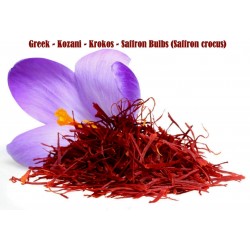
Saffron Bulbs (Saffron crocus)
Price
€3.75
SKU: MHS 105 B
Seeds Gallery Com,
5/
5
<!DOCTYPE html>
<html>
<head>
<meta http-equiv="Content-Type" content="text/html; charset=UTF-8" />
</head>
<body>
<h2><strong>Saffron Bulbs (Saffron crocus)</strong></h2>
<h2><span style="color: #ff0000;"><strong>Price for Package of 1 bulb.</strong></span></h2>
<p><span style="color: #000000; font-family: helvetica, arial, sans-serif;">Crocus sativus, commonly known as saffron crocus, or autumn crocus,[2] is a species of flowering plant of the Crocus genus in the Iridaceae family. It is best known for producing the spice saffron from the filaments that grow inside the flower. The term "autumn crocus" is also mistakenly used for flowers in the Colchicum species. However, crocuses have 3 stamens and 1 style, while colchicum have 6 stamens and 3 styles and are toxic.</span></p>
<p><span style="color: #000000; font-family: helvetica, arial, sans-serif;">This cormous autumn-flowering perennial plant species is unknown in the wild.[2] Human cultivation of saffron crocus and use of saffron have taken place for more than 3,500 years and spans different cultures, continents, and civilizations, see history of saffron. Crocus sativus is currently known to grow in the Mediterranean, East Asia, and Irano-Turanian Region.[4] Saffron may be the triploid form of a species found in Eastern Greece, Crocus cartwrightianus; it probably appeared first in Crete. An origin in Western or Central Asia, although often suspected, is not supported by botanical research.[5] Other sources suggest some genetic input from Crocus pallasii.</span></p>
<p><span style="color: #000000; font-family: helvetica, arial, sans-serif;"><strong>Morphology</strong></span></p>
<p><span style="color: #000000; font-family: helvetica, arial, sans-serif;">Crocus sativus has a corm, which holds leaves, bracts, bracteole, and the flowering stalk.[4] These are protected by the corm underground. C. sativus generally blooms with purple flowers in the autumn. The plant grows about 10 to 30 cm high.[7] C. sativus is a triploid with 24 chromosomes, which means it has three times the haploid number of chromosomes. This makes the plant sterile due to its inability to pair chromosomes during meiosis.</span></p>
<p><span style="color: #000000; font-family: helvetica, arial, sans-serif;"><strong>Cultivation</strong></span></p>
<p><span style="color: #000000; font-family: helvetica, arial, sans-serif;">Crocus sativus is unknown in the wild, and its ancestor is unknown. The species Crocus cartwrightianus is the most probable ancestor,[9][6] but C. thomassi and C. pallasii are still being considered as potential predecessors.[10] Manual vegetative multiplication is necessary to produce offspring for this species as the plant itself is a triploid that is self-incompatible and male sterile, therefore rendering it incapable of sexual reproduction. This inability to reproduce on its own supports the hypothesis that C. sativus is a mutant descending from C. carthwrightianus as a result of selective breeding.</span></p>
<p><span style="color: #000000; font-family: helvetica, arial, sans-serif;">Corms of Crocus sativus should be planted 4 inches apart and in a trough 4 inches deep. The flower grows best in areas of full sun in well-drained soil with moderate levels of organic content.[11] The corms will multiply after each year, and will last 3–5 years.</span></p>
<p><span style="color: #000000; font-family: helvetica, arial, sans-serif;"><strong>Use</strong></span></p>
<p><span style="color: #000000; font-family: helvetica, arial, sans-serif;">Saffron is considered to be the most valuable spice by weight. <strong>See spice</strong>. Depending on the size of harvested stigmas, 50,000–75,000 Crocus sativus plants are needed to produce about 1 pound of saffron;[13] each flower only produces three stigmas. Stigmas should be harvested mid-morning when the flowers are fully opened.[12] The saffron crocus (Crocus sativus) should not be confused with "meadow" saffron or autumn crocus (Colchicum autumnale) which is poisonous.</span></p>
<p><span style="color: #000000; font-family: helvetica, arial, sans-serif;"><strong>Spice</strong></span></p>
<p><span style="color: #000000; font-family: helvetica, arial, sans-serif;">Saffron (pronounced /ˈsæfrən/ or /ˈsæfrɒn/)[1] is a spice derived from the flower of Crocus sativus, commonly known as the "saffron crocus". The vivid crimson stigmas and styles, called threads, are collected and dried to be used mainly as a seasoning and colouring agent in food. Saffron, long among the world's most costly spices by weight,[2][3][4] was probably first cultivated in or near Greece.[5] C. sativus is probably a form of C. cartwrightianus, that emerged by human cultivators selectively breeding plants for unusually long stigmas in late Bronze Age Crete.[6] It slowly propagated throughout much of Eurasia and was later brought to parts of North Africa, North America, and Oceania.</span></p>
<p><span style="color: #000000; font-family: helvetica, arial, sans-serif;">Saffron's taste and iodoform or hay-like fragrance result from the chemicals picrocrocin and safranal.[7][8] It also contains a carotenoid pigment, crocin, which imparts a rich golden-yellow hue to dishes and textiles. Its recorded history is attested in a 7th-century BC Assyrian botanical treatise compiled under Ashurbanipal,[9] and it has been traded and used for over four millennia. Iran now accounts for approximately 90% of the world production of saffron.</span></p>
<p><span style="color: #000000; font-family: helvetica, arial, sans-serif;">The domesticated saffron crocus, Crocus sativus, is an autumn-flowering perennial plant unknown in the wild. It probably descends from the eastern Mediterranean autumn-flowering Crocus cartwrightianus,[12][13] which is also known as "wild saffron"[14] and originated in Crete[15] or mainland Greece.[8] An origin in Southwest Asia,[3][16] although often suspected, has been disapproved by botanical research.[17] The saffron crocus probably resulted when C. cartwrightianus was subjected to extensive artificial selection by growers seeking longer stigmas. C. thomasii and C. pallasii are other possible sources.[13][18] As a genetically monomorphic clone,[15] it slowly propagated throughout much of Eurasia.</span></p>
<p><span style="color: #000000; font-family: helvetica, arial, sans-serif;">It is a sterile triploid form, which means that three homologous sets of chromosomes compose each specimen's genetic complement; C. sativus bears eight chromosomal bodies per set, making for 24 in total.[19] Being sterile, the purple flowers of C. sativus fail to produce viable seeds; reproduction hinges on human assistance: clusters of corms, underground, bulb-like, starch-storing organs, must be dug up, divided, and replanted. A corm survives for one season, producing via this vegetative division up to ten "cormlets" that can grow into new plants in the next season.[12] The compact corms are small, brown globules that can measure as large as 5 cm (2 in) in diameter, have a flat base, and are shrouded in a dense mat of parallel fibres; this coat is referred to as the "corm tunic". Corms also bear vertical fibres, thin and net-like, that grow up to 5 cm (2 in) above the plant's neck.[19]</span></p>
<p><span style="color: #000000; font-family: helvetica, arial, sans-serif;">The plant sprouts 5–11 white and non-photosynthetic leaves known as cataphylls. These membrane-like structures cover and protect the crocus's 5 to 11 true leaves as they bud and develop. The latter are thin, straight, and blade-like green foliage leaves, which are 1–3 mm (0.04–0.12 in), in diameter, which either expand after the flowers have opened ("hysteranthous") or do so simultaneously with their blooming ("synanthous"). C. sativus cataphylls are suspected by some to manifest prior to blooming when the plant is irrigated relatively early in the growing season. Its floral axes, or flower-bearing structures, bear bracteoles, or specialised leaves, that sprout from the flower stems; the latter are known as pedicels.[19] After aestivating in spring, the plant sends up its true leaves, each up to 40 cm (16 in) in length. Only in October, after most other flowering plants have released their seeds, do its brilliantly hued flowers develop; they range from a light pastel shade of lilac to a darker and more striated mauve.[20] The flowers possess a sweet, honey-like fragrance. Upon flowering, the plants are 20–30 cm (8–12 in) in height and bear up to four flowers. A three-pronged style 25–30 mm (1.0–1.2 in) in length, emerges from each flower. Each prong terminates with a vivid crimson stigma, which are the distal end of a carpel.</span></p>
<p><span style="color: #000000; font-family: helvetica, arial, sans-serif;"><strong>Cultivation</strong></span></p>
<p><span style="color: #000000; font-family: helvetica, arial, sans-serif;">The saffron crocus, unknown in the wild, probably descends from Crocus cartwrightianus. It is a triploid that is "self-incompatible" and male sterile; it undergoes aberrant meiosis and is hence incapable of independent sexual reproduction—all propagation is by vegetative multiplication via manual "divide-and-set" of a starter clone or by interspecific hybridisation.</span></p>
<p><span style="color: #000000; font-family: helvetica, arial, sans-serif;">Crocus sativus thrives in the Mediterranean maquis, an ecotype superficially resembling the North American chaparral, and similar climates where hot and dry summer breezes sweep semi-arid lands. It can nonetheless survive cold winters, tolerating frosts as low as −10 °C (14 °F) and short periods of snow cover.[12][22] Irrigation is required if grown outside of moist environments such as Kashmir, where annual rainfall averages 1,000–1,500 mm (39–59 in); saffron-growing regions in Greece (500 mm or 20 in annually) and Spain (400 mm or 16 in) are far drier than the main cultivating Iranian regions. What makes this possible is the timing of the local wet seasons; generous spring rains and drier summers are optimal. Rain immediately preceding flowering boosts saffron yields; rainy or cold weather during flowering promotes disease and reduces yields. Persistently damp and hot conditions harm the crops,[23] and rabbits, rats, and birds cause damage by digging up corms. Nematodes, leaf rusts, and corm rot pose other threats. Yet Bacillus subtilis inoculation may provide some benefit to growers by speeding corm growth and increasing stigma biomass yield.</span></p>
<p><span style="color: #000000; font-family: helvetica, arial, sans-serif;">The plants fare poorly in shady conditions; they grow best in full sunlight. Fields that slope towards the sunlight are optimal (i.e., south-sloping in the Northern Hemisphere). Planting is mostly done in June in the Northern Hemisphere, where corms are lodged 7–15 cm (3–6 in) deep; its roots, stems, and leaves can develop between October and February.[19] Planting depth and corm spacing, in concert with climate, are critical factors in determining yields. Mother corms planted deeper yield higher-quality saffron, though form fewer flower buds and daughter corms. Italian growers optimise thread yield by planting 15 cm (6 in) deep and in rows 2–3 cm (0.8–1.2 in) apart; depths of 8–10 cm (3–4 in) optimise flower and corm production. Greek, Moroccan, and Spanish growers employ distinct depths and spacings that suit their locales.</span></p>
<p><span style="color: #000000; font-family: helvetica, arial, sans-serif;">C. sativus prefers friable, loose, low-density, well-watered, and well-drained clay-calcareous soils with high organic content. Traditional raised beds promote good drainage. Soil organic content was historically boosted via application of some 20–30 tonnes (20–30 long tons; 22–33 short tons) of manure per hectare. Afterwards, and with no further manure application, corms were planted.[25] After a period of dormancy through the summer, the corms send up their narrow leaves and begin to bud in early autumn. Only in mid-autumn do they flower. Harvests are by necessity a speedy affair: after blossoming at dawn, flowers quickly wilt as the day passes.[26] All plants bloom within a window of one or two weeks.[27] Stigmas are dried quickly upon extraction and (preferably) sealed in airtight containers.</span></p>
<p><span style="color: #000000; font-family: helvetica, arial, sans-serif;">One freshly picked flower yields an average 30 mg (0.0011 oz) of fresh saffron or 7 mg (0.00025 oz) dried; roughly 150 flowers yield 1 g (0.035 oz) of dry saffron threads; to produce 12 g (0.42 oz) of dried saffron, 1 kg (2.2 lb) of flowers are needed; 1 lb (0.45 kg) yields 0.2 oz (5.7 g) of dried saffron.[25] To glean 1 lb (450 g) of dry saffron requires the harvest of 50,000–75,000 flowers; a kilogram requires 110,000–170,000 flowers.[29][30] Forty hours of labour are needed to pick 150,000 flowers.</span></p>
<p><span style="color: #000000; font-family: helvetica, arial, sans-serif;"><strong>Trade</strong></span></p>
<p><span style="color: #000000; font-family: helvetica, arial, sans-serif;">Almost all saffron grows in a belt from Spain in the west to India in the east. The other continents, except Antarctica, produce smaller amounts. In 2014, 250 t (250,000 kg) were produced worldwide.[47] Iran is responsible for around 90–93% of global production, and much of their produce is exported.[10] A few of Iran's drier eastern and southeastern provinces, including Fars, Kerman, and those in the Khorasan region, glean the bulk of modern global production. In 2005, second-ranked Greece produced 5.7 t (5,700 kg), while Morocco (the Berber region of Taliouine), and India (Kashmir), tied for third rank, each producing 2.3 t (2,300 kg).</span></p>
<p><span style="color: #000000; font-family: helvetica, arial, sans-serif;">In recent years, Afghan cultivation has risen. Azerbaijan, Morocco, and Italy are, in decreasing order, lesser producers. Prohibitively high labour costs and abundant Iranian imports mean that only select locales continue the tedious harvest in Austria, Germany, and Switzerland—among them the Swiss village of Mund, whose annual output is a few kilograms.[8] Microscale production of saffron can be found in Australia (mainly the state of Tasmania),[48] China, Egypt, parts of England[49] France, Israel, Mexico, New Zealand, Sweden (Gotland), Turkey (mainly around the town of Safranbolu), the United States (California and Pennsylvania), and Central Africa.</span></p>
<p><span style="color: #000000; font-family: helvetica, arial, sans-serif;">Saffron prices at wholesale and retail rates range from US$500 to US$5,000 per pound, or US$1,100–11,000/kg. In Western countries, the average retail price in 1974 was $1,000 per pound or US$2,200 per kilogram.[3] In February 2013, a retail bottle containing 0.06 ounces could be purchased for $16.26 or the equivalent of $4,336 per pound or as little as about $2,000/pound in larger quantities. A pound contains between 70,000 and 200,000 threads. Vivid crimson coloring, slight moistness, elasticity, and lack of broken-off thread debris are all traits of fresh saffron.</span></p>
<p><span style="color: #000000; font-family: helvetica, arial, sans-serif;"><strong>Uses</strong></span></p>
<p><span style="color: #000000; font-family: helvetica, arial, sans-serif;">Saffron's aroma is often described by connoisseurs as reminiscent of metallic honey with grassy or hay-like notes, while its taste has also been noted as hay-like and sweet. Saffron also contributes a luminous yellow-orange colouring to foods. Saffron is widely used in Persian,[50] Indian, European, and Arab cuisines. Confectioneries and liquors also often include saffron. Saffron is used in dishes ranging from the jewelled rice and khoresh of Iran, [51][52] the Milanese risotto of Italy, the paella of Spain, the bouillabaisse of France, to the biryani with various meat accompaniments in South Asia. One of the most esteemed use for saffron is in the preparation of the Golden Ham, a precious dry-cured ham made with saffron from San Gimignano. Common saffron substitutes include safflower (Carthamus tinctorius, which is often sold as "Portuguese saffron" or "açafrão"), annatto, and turmeric (Curcuma longa).</span></p>
<p><span style="color: #000000; font-family: helvetica, arial, sans-serif;">Saffron has a long history of use in traditional medicine.[53][54] Saffron has also been used as a fabric dye, particularly in China and India, and in perfumery.[55] It is used for religious purposes in India.</span></p>
<p><span style="color: #000000; font-family: helvetica, arial, sans-serif;"><strong>Nutrition</strong></span></p>
<p><span style="color: #000000; font-family: helvetica, arial, sans-serif;">Dried saffron is composed of 12% water, 65% carbohydrates, 6% fat and 11% protein (table).</span></p>
<p><span style="color: #000000; font-family: helvetica, arial, sans-serif;">In comparison to other spices or dried foods, the nutrient content of dried saffron shows richness of nutritional value across B vitamins and dietary minerals (table). In a serving of one tablespoon (2 grams), manganese is present as 28% of the Daily Value while other nutrients are negligible (table).</span></p>
</body>
</html>
MHS 105 B

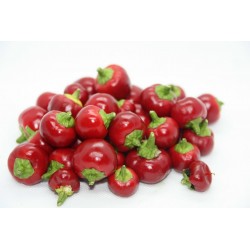
Satans Kiss Chili Seeds
Price
€2.25
SKU: C 51
Seeds Gallery Com,
5/
5
<h2><span style="text-decoration: underline;" class=""><strong><em>Satans Kiss Chili Seeds</em></strong></span></h2>
<h3><span style="color: #ff3000;"><strong>Price for Package of 10 seeds.</strong></span></h3>
<p>A popular, fast growing chili variety from southern Italy. Satan's Kiss, also called Baccio Ciliegia Piccante or the Satana, is an heirloom variety. It will get a lot of golf ball sized hot peppers. It is a sturdy plant. This chili is delicious in many dishes. Traditionally Satans Kiss is stuffed with anchovies and mozzarella and then grilled.</p>
<p>Minimum height of plant: 60cm</p>
<p>Maximum height of plant: 90cm</p>
<p><strong>Capsicum annuum</strong></p>
<p><strong>Scoville Units: 40.000 - 50.000</strong></p><script src="//cdn.public.n1ed.com/G3OMDFLT/widgets.js"></script>
C 51

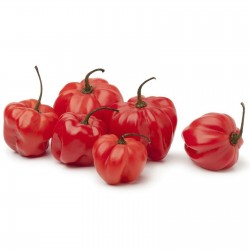
Scotch Bonnet Trinidad Seeds
Price
€1.50
SKU: C 16
Seeds Gallery Com,
5/
5
<h2><span style="text-decoration:underline;"><em><strong>Scotch Bonnet Trinidad Seeds</strong></em></span></h2>
<h3><span style="color:#ff0000;"><strong>Price for Pack of 3 or 20 seeds.</strong></span></h3>
<p><span style="font-size:10.909090995788574px;line-height:1.5em;"><span style="font-size:10pt;">One of the all time classic chillies. There are many different strains of this classic, this being from the Island of Trinidad. Good Heat, Great Flavour, always a great grower. The Scotch Bonnet is not the same chilli as the Habanero they are of the same species but the Scotch Bonnet is not a Cultivar. The Scotch Bonnet has a different shape - one which closely resembles a Scot's bonnet - so it is very easy to differentiate the two. It grows mainly in the Caribbean islands while the Habanero grows mainly in Latin and North American. The flavour of the two, however, is very similar as is their heat Level. The Scotch Bonnet Red is 1 to 1-1/2 inches in diameter, is irregularly shaped. Some say the flavour is even more tropical and fruity than the Habanero. It is great for salsas and sauces. (Capsicum Chinense).</span><br /></span></p>
C 16

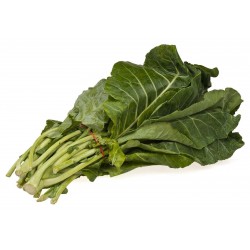
Sea kale, Sea cole Seeds...
Price
€1.95
SKU: VE 188
Seeds Gallery Com,
5/
5
<div id="idTab1" class="rte">
<h2><strong>Sea kale, Sea cole, Seakale Seeds (Crambe maritima)</strong></h2>
<h2><span style="color: #ff0000;"><strong>Price for Package of 20 seeds.</strong></span></h2>
<p class="">Crambe maritima (common name sea kale, seakale or crambe) is a species of halophytic flowering plant in the genus Crambe of the family Brassicaceae (Cruciferae), that grows wild along the coasts of Europe, from the North Atlantic to the Black Sea.</p>
<p><strong>Description</strong></p>
<p>Growing to 75 cm (30 in) tall by 60 cm (24 in) wide, it is a mound-forming, spreading perennial. It has large fleshy glaucous collard-like leaves and abundant white flowers. The seeds come one each in globular pods.</p>
<p><strong>Distribution</strong></p>
<p>Very rare in Northern Ireland, recorded from Counties Down and Antrim and from a number of seaside counties of Ireland.</p>
<p><strong>Culinary use</strong></p>
<p>The plant is cultivated as a vegetable, related to the cabbage.</p>
<p>Along the coast of England, where it is commonly found above high tide mark on shingle beaches, local people heaped loose shingle around the naturally occurring root crowns in springtime, thus blanching the emerging shoots. By the early eighteenth century, it had become established as a garden vegetable, but its height of popularity was the early nineteenth century when sea kale appeared in Thomas Jefferson's Garden Book of 1809. It was also served at the Royal Pavilion in Brighton, when Prince Regent George IV of the United Kingdom (1762–1830) used it as a seaside retreat.</p>
<p>The shoots are served like asparagus: steamed, with either a béchamel sauce or melted butter, salt and pepper. It is apt to get bruised or damaged in transport and should be eaten very soon after cutting, this may explain its subsequent decline in popularity. However, given a rich, deep and sandy soil, it is easy to propagate and grow on from root cuttings available from specialist nurseries. Blanching may be achieved by covering it with opaque material or using a deep, loose and dry mulch.</p>
<p><strong>As an ornamental plant</strong></p>
<p>As an ornamental garden plant, C. maritima has gained the Royal Horticultural Society's Award of Garden Merit.</p>
</div><script src="//cdn.public.n1ed.com/G3OMDFLT/widgets.js"></script>
VE 188 (20 S)


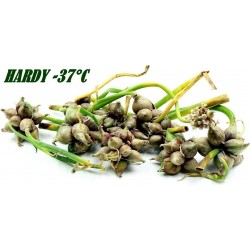
Seeds - Tree Onions,...
Price
€7.95
SKU: P 353
Seeds Gallery Com,
5/
5
<!DOCTYPE html>
<html>
<head>
<meta http-equiv="Content-Type" content="text/html; charset=UTF-8" />
</head>
<body>
<h2><strong>Seeds - Tree Onions, Egyptian Walking Onions, Topsetting Onions</strong></h2>
<h2><span style="color: #ff0000;"><strong>Price for Package of 3 bulbs.</strong></span></h2>
<p>As their scientific name "Allium proliferum" states, these hardy little onions are very "prolific." After planting them in your garden you will have onions every year for years to come! Egyptian Walking Onions are also called "Tree Onions, Egyptian Tree Onions, Top Onions, Winter Onions, or Perennial Onions."</p>
<p>Egyptian Walking Onions are one of the first plants to emerge in the spring. The leaves poke up through the soil like little green spikes and shoot towards the sky despite the frost or snow. The blue-green leaves are round and hollow and will grow up to 3 feet in height. At the the end of a leaf stalk, at the top of the plant, a cluster of bulblets will begin to grow. These bulblets are also known as "bulbils" or "sets." We will refer to them as "topsets" throughout this website. Every Egyptian Walking Onion plant will produce a cluster of sets at the top, hence the name, "Top Onion," meaning they are top-setting onions.</p>
<p>In early spring topsets first appear encased in a protective papery tunic. As they grow, this papery capsule will tear open and eventually fall off.</p>
<p>The topsets reach maturity in late summer. Many of them have little green sprouts and mini root nodules. They look like mini versions of the parent plant. When the topsets become heavy enough, they will pull the plant over to the ground. If the soil conditions are right, the fallen topsets will take root and grow into new Egyptian Walking Onion plants, hence the name, "Walking Onion." They will literally walk across your garden!</p>
<p>Although the Egyptian Walking Onion is a top-setting onion, it will occasionally produce miniature flowers among its topsets. The flowers are about 1/4" wide. They have 6 white petals and 6 stamens. Each petal has a vertical pea-green stripe. Most of the flowers dry up and wither as the topsets compete with them for energy. So an Egyptian Walking Onion seed is a rarity - at least I've never seen a mature and viable one.</p>
<p>An Egyptian Walking Onion topset looks like, and essentially is, a miniature onion. Topsets produced by these plants are generally smaller than the ordinary annual garden variety onion sets. They range in size from 1/4 inch to 1 inch in diameter. Each cluster can have as few as 1 or 2 topsets, or as many as 30 or more topsets. Sometimes a new leaf stalk will emerge from a cluster of topsets like a little branch, and a second cluster will grow from it, hence the name, "Tree Onion."</p>
<p>In the ground, the Egyptian Walking Onion plant produces a small shallot-like onion which can be harvested. Once harvested, however, the plant will obviously not grow back. If left in the ground, the onion will divide and form a cluster of onion bulbs. New leaves and topsets will grow from the onions each year. The bulbs in the photo on the right grew from one mature Egyptian Walking Onion bulb in one growing season - 1 plant became 6 plants!</p>
<p>There is a lot of variation in Egyptian Walking Onion plants. Some plants form long, twisting branches and very few topsets, while others produce large clusters of topsets and no branches. Some plants grow only 2 topsets and others will grow 30! Every plant is so unique and beautiful. They can be grown for both food and ornamental purposes.</p>
<p>Egyptian Walking Onions are perennial plants and will grow back each year and yield new and bigger clusters of sets on the top and new onion bulbs in the soil - they will divide. During their first year of growth they will not produce topsets (although there are some exceptions depending on your growing conditions). You might see only greens the first year. But don't be disappointed, your Egyptian Walking Onion plants will grow back the following year in full force and produce their first clusters of topsets. Once established, plants may be propagated by division or by planting the topsets. Egyptian Walking Onions are extremely hardy plants. Our plants have endured harsh winters with temperatures plummeting down to -24° below zero! Hence the name, "Winter Onion." They grow well in zones 3-9.</p>
<h2>How and when to plant your Egyptian Walking Onion sets:</h2>
<p>Plant each "topset" in the soil about 2 inches deep. Soil should be slightly moist and well drained. Egyptian Walking Onions hate wet feet! Plant in rows about 1 foot apart. The sets should be spaced approximately 6-10 inches apart in each row. Plant in full sunlight. Partial shade is ok too, but full sun is the best for optimal growth. Egyptian Walking Onion sets can also be planted in clusters. When planted this way they make a great addition to your herb garden. They can even be planted in pots to be kept outside or indoors. They can be planted any time of the year even in the winter as long as the ground isn't frozen or covered with snow. However, fall is the optimal time to plant them so they can develop a strong root system and be ready for good growth the following spring. NOTE: Egyptian Walking Onions topsets will not produce topsets during their first year of growth (although I have seen the "jumbo" topsets produce tiny topsets during their first year of growth). Topsets will grow during the plant's second year and every year thereafter. The following is a list of what to expect when planting your sets at different times of the year:</p>
<p><strong>Planting in the spring</strong>: This is a good time to plant your Egyptian Walking onion topsets. The topsets will grow throughout the spring and summer and develop tall green leaves and bulb/root growth in the ground. Since it is the plant's first growing season, it will probably not produce topsets, unless it is a huge (jumbo) topset.</p>
<p><strong>Planting in the summer</strong>: Topsets planted at this time will grow roots and leafstalks, and have some onion bulb development in the ground, but they will not produce topsets.</p>
<p><strong>Planting in the fall</strong>: This is the optimum time to plant your Egyptian Walking Onion topsets. Topsets planted at this time will grow roots and leafstalks only. The leafstalk will die back for the winter. The topset will develop into a small onion bulb in the ground and store enough energy to carry itslef through the winter. A leafstalk will reemerge in the spring and the plant will grow throughout the spring and summer to maturity. More than likely, there will be no topset growth the first summer, but some plants have produced topsets their first summer after planting in the fall.</p>
<p><strong>Planting in the winter</strong>: Yes! You can plant Egyptian Walking Onion topsets in the winter as long as the soil is not frozen. If you can dig a 2" deep hole in the soil, then you can plant your sets. The topsets will not grow much at all - maybe a little bit of root growth only, unless you live where the winters are mild. If this is the case, you might also get a leafstalk. When planting in the winter, mulching is a good idea. In fact, mulching is good practice at any time of the year. Mulching keeps the weeds down, prevents unnecessary water evaporation and erosion, and fertilizes your plants.</p>
<p><strong>Planting by Nature</strong>: unharvested topsets that are left to lie on the ground will self-sew. No planting necessary, they will grown on their own.</p>
<h2>How to Harvest Your Egyptian Walking Onions:</h2>
<p><strong>Harvesting the topsets</strong>: In mid to late summer and autumn the topsets may be harvested. The optimal time to pluck off the topsets is when the stalk has dried and turned brown. More than likely, it has fallen over by this time. Be sure to remove any topsets that have fallen to the ground if you do not want them to self-sow in their new locations. Despite their name, these plants are very easy to control and keep from spreading just by harvesting the topsets. You can eat, plant, or store your Egyptian Walking Onion topsets.</p>
<p><strong>Harvesting the greens</strong>: The greens (leaves) may be cut and harvested at any time of the year. Just harvest one or two leaves from each plant. Be careful not to cut the stalk that has the topsets. Soon after you have harvested the leaves from an Egyptian Walking Onion plant, new leaves will start to grow in their place which can be harvested again. If you live in a mild climate, your Egyptian Walking Onion plant may produce greens all year round. In the fall after the topsets have matured and fallen to the ground, or after they have been harvested, new greens will start to grow - yummy!</p>
<p><strong>Harvesting the onion bulbs in the ground</strong>: The onions at the base of the plant that are growing in the ground can be harvested in late summer and fall. Be sure to leave some onions in the ground for next year's crop. An Egyptian Walking Onion bulb is about the same size and shape as a shallot. Bigger bulbs may be obtained by cutting off the topsets before they develop. That way the plant can put its energy into the onion bulb in the ground instead of into the topsets. Note: if you harvest the onion bulb in the ground, you will destroy the plant - it will not grow back next year. So, if you want to eat the onion bulbs in the ground, make sure to replace them by planting topsets, or offsets from the bulb (divisions).</p>
<h2>How to eat your Egyptian Walking Onions:</h2>
<p>Egyptian Walking Onions taste just like a regular onion, only with a bit more pizzazz! The entire plant can be eaten. Shallot-like onions form at the base in the soil. They can be eaten and prepared just like any other onion. The hollow greens may be chopped to eat like chives or green onions. They are excellent when fried, cooked in soups, or raw in salads (my favorite). The topsets are excellent when peeled and fried. You can even pickle them. Or just pop them in your mouth like popcorn! Watch out, they're a little spicy!</p>
<h2>Names of the Egyptian Walking Onion:</h2>
<p><strong>Common names:</strong></p>
<p>"Egyptian Walking Onion" or "Walking Onion": The name "Egyptian" is very mysterious. The ancient Egyptians worshipped onions. They believed that its spherical shape and concentric rings symbolized eternal life. Onions were even used in Egyptian burials for the pharaohs. Small onions were found in the eye sockets of Ramesses IV. It is not known whether the Egyptian Walking Onion came from the Egyptians or not. The "Egyptian" part of the name remains a mystery. Maybe the name refers to the way they walk.....do they "walk like an Egyptian?"</p>
<p>The name "Walking Onion" was given to this plant because it literally walks to new locations. When the cluster of topsets becomes heavy enough, it will pull the plant over to the ground. Depending on how tall the plant is and where the bend occurs, the topsets may fall up to 3 feet away from the base of the plant. Here, if the conditions are right, they will take root and grow new plants. When these new plants mature, their topsets will eventually fall to the ground and start the process all over again. Egyptian Walking Onion plants can walk between 1 and 3 feet per year!</p>
<p>"Tree Onion": Egyptian Walking Onions are known for their ability to grow a twisting stalk from the cluster of sets at the top of the plant. Another cluster of sets will grow at the end of this second stalk giving the plant a branching, tree-like appearance.</p>
<p>"Top Onion", "Topset Onion", or "Top Setting Onion": Egyptian Walking Onions grow a cluster of sets at the top of the plant instead of seeds.</p>
<p>"Winter Onion": These Onions can survive freezing cold winters with temperatures plummeting well below 24°F! They are hardy to zone 3.</p>
<p><strong>Taxonomic names:</strong></p>
<p>The following three scientific names refer to the Egyptian Walking Onion plant:</p>
<p>Allium cepa var. proliferum</p>
<p>Egyptian Walking Onions are proliferous. A proliferous plant produces new individuals by budding. This type of plant also produces offshoots, especially from unusual places. In the case of the Egyptian Walking Onion, an offshoot will grow out form cluster of sets. Proliferous plants produce an organ or shoot from an organ that is itself normally the last, as a shoot or a new flower from the midst of a flower. In the case of the Egyptian Walking Onion, a cluster of topsets grows from a cluster of topsets forming a multi-tiered plant.</p>
<p>Allium cepa var. bulbiferous</p>
<p>Egyptian Walking Onions are bulbiferous. They produce bulbs!</p>
<p>Allium cepa var. viviparum</p>
<p>Eyptian Walking Onions are viviparous. They produce bulbils or new plants rather than seed. Egyptian Walking Onion sets germinate while still attached to the parent plant. They can be seen growing leaves and roots before they ever touch the ground.</p>
<p>Kingdom: Plantae (plants)</p>
<p>Subkingdom: Viridaeplantae (green plants)</p>
<p>Infrakingdom: Streptophyta (land plants)</p>
<p>Division: Tracheophyta (vascular plants)</p>
<p>Subdivision: Spermatophytina (seed plants)</p>
<p>Infradivision: Angiospermae (flowering plants)</p>
<p>Class: Magnoliopsida</p>
<p>Superorder: Lilianae (monocotyledon - having one seed leaf)</p>
<p>Order: Asparagales</p>
<p>Family: Amaryllidaceae</p>
<p>Subfamily: Allioideae</p>
<p>Genus: Allium (onion)</p>
<p>Species: cepa</p>
<p>Variations: </p>
<p>proliferum</p>
<p>bulbiferum</p>
<p>viviparum</p>
<p>multiplicans</p>
<p> </p>
</body>
</html>
P 353



